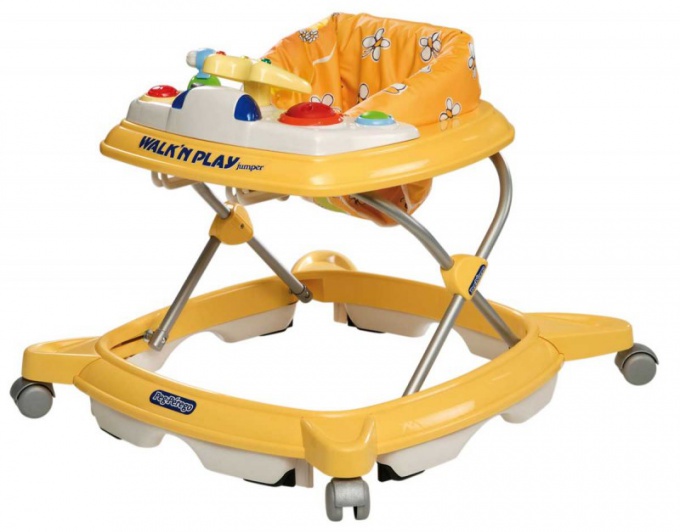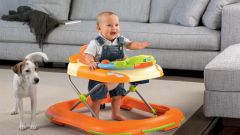Types of walkers
There are two fundamentally different kinds of baby walkers. The first of these is a structure very similar to the baby highchair frame on four wheels. These walkers are often equipped with various musical buttons to entertain baby, or a small table where to put toys. The second type is more like a swing. Walkers of this type are mounted in a doorway or the space between the walls. This kind of leads to less maneuverability and freedom of movement of the child. In both cases, Walker provided a place to sit in which seat holds the baby.
Walker on wheels child can relatively freely move in space. Walker-swing is designed more for the peace of mind of parents.
When put in a Walker
Any invention in the nursery industry produces a sensation, the walkers were no exception. Their main function is to help the child to learn to walk. Do they do their function?
The first question to ask yourself: at what age a child can be put in a Walker? Should not forcibly to hasten natural processes. Child around learning when his body is so much stronger, what may, without any danger to move on to the next "level". First, the child must learn to sit, and sit he must surely, not to be filled up in different directions. This usually occurs at the age of 7-8 months. If you put the child in a Walker too early, there is a risk of damaging his spine. So, your child is sitting, even better if it's already well worth it, then you can be sure that you will not hurt your baby's health.
Back to the main question: do walkers learn the child to go? Of course, for kids there is a significant difference in viewing from the seated and standing positions. When the child is standing, he can see farther and higher, which means that it offers more opportunities to explore the surrounding world. Considering this aspect, the walkers perform their function and encourage the child to walk.
The pros and cons
Like any invention, they have their positive and negative sides. Before buying, make sure that walkers do the right thing for your kid. Think about how much time your child will spend in a Walker, and will favor him this time?
Of course, Walker is an indispensable thing when you must do household chores. You can be sure that the child in the Walker can't hurt or injure yourself. However, even such young children are very resourceful and can get out of tight design. Therefore, no child should be left unattended, even if it is in the Walker.
On the other hand, in the Walker, the child is sitting, and therefore does not put the whole foot on the solid floor surface, touching it only with her toes. This position will not allow the right foot to be formed, and this will further slow down the learning of the kid walking. The movement of the walkers is due to the inclination of the case forward that contrary to the General principle of the walk - balance. Walkers protect the child from falling, but real-time protection does more harm to baby than good.
Do not think that walkers teach baby to walk, it is possible to learn the most, so let a child try their hand.
If the child is under continuous adult supervision, think again, weigh the pros and cons, read reviews of the Walker and related forums on the Internet, it is likely that your child just don't want it.

